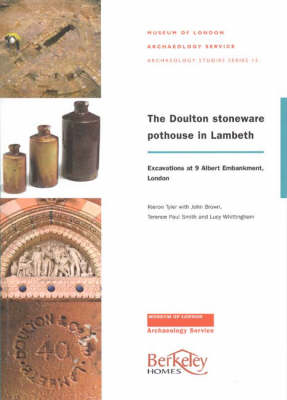
The Doulton Stoneware Pothouse in Lambeth
Excavations at 9 Albert Embankment, London
Seiten
2006
Museum of London Archaeology Service (Verlag)
978-1-901992-63-2 (ISBN)
Museum of London Archaeology Service (Verlag)
978-1-901992-63-2 (ISBN)
- Titel ist leider vergriffen;
keine Neuauflage - Artikel merken
Excavations at 9 Albert Embankment in the London Borough of Lambeth uncovered important new evidence for one of the lesser-known 'pothouses' of the Doulton company. This small pottery factory operated from the 1870s to 1926 and its main products were stoneware bottles, essentially the containers for products such as ginger beer and ink.
Excavations at 9 Albert Embankment in the London Borough of Lambeth uncovered important new evidence for one of the lesser-known 'pothouses' of the Doulton company. This small pottery factory operated from the 1870s to 1926 and its main products were stoneware bottles, essentially the containers for products such as ginger beer and ink. While these types of stoneware vessel are a common find on archaeological sites, their actual manufacturing process has rarely been studied. The remains of five 'downdraught' pottery kilns were recorded in the MoLAS excavations of 2001-2. Two of the kilns formed part of the first pothouse of the 1870s, and there were three more kilns from the enlarged pothouse of the 1890s. At their demolition, the kilns were backfilled with a mixture of whole pots, kiln furniture and refractory bricks: it is this significant body of material that has enabled a study of both the products and the manufacturing process. The book sets the pottery in its historical context, and explores the links between Henry Doulton, the proprietor, and other Victorian businessmen. The publication shows how Doulton exploited Lambeth in pursuit of the mass market.
Excavations at 9 Albert Embankment in the London Borough of Lambeth uncovered important new evidence for one of the lesser-known 'pothouses' of the Doulton company. This small pottery factory operated from the 1870s to 1926 and its main products were stoneware bottles, essentially the containers for products such as ginger beer and ink. While these types of stoneware vessel are a common find on archaeological sites, their actual manufacturing process has rarely been studied. The remains of five 'downdraught' pottery kilns were recorded in the MoLAS excavations of 2001-2. Two of the kilns formed part of the first pothouse of the 1870s, and there were three more kilns from the enlarged pothouse of the 1890s. At their demolition, the kilns were backfilled with a mixture of whole pots, kiln furniture and refractory bricks: it is this significant body of material that has enabled a study of both the products and the manufacturing process. The book sets the pottery in its historical context, and explores the links between Henry Doulton, the proprietor, and other Victorian businessmen. The publication shows how Doulton exploited Lambeth in pursuit of the mass market.
by Kieron Tyler with John Brown, Terence Paul Smith and Lucy Whittingham
| Erscheint lt. Verlag | 24.1.2006 |
|---|---|
| Zusatzinfo | 69 b/w illus, 10 tabs |
| Verlagsort | London |
| Sprache | englisch |
| Maße | 210 x 297 mm |
| Themenwelt | Geisteswissenschaften ► Archäologie |
| ISBN-10 | 1-901992-63-2 / 1901992632 |
| ISBN-13 | 978-1-901992-63-2 / 9781901992632 |
| Zustand | Neuware |
| Haben Sie eine Frage zum Produkt? |
Mehr entdecken
aus dem Bereich
aus dem Bereich
Holocaust heritage, noncitizen futures, and black power in Berlin
Buch | Softcover (2022)
University of California Press (Verlag)
37,40 €
Life, Death and Disease in the Middle Ages and Beyond
Buch | Hardcover (2024)
Simon & Schuster Ltd (Verlag)
27,40 €


